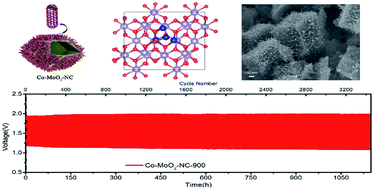Tuning and understanding the electronic effect of Co–Mo–O sites in bifunctional electrocatalysts for ultralong-lasting rechargeable zinc–air batteries†
Abstract
Herein, we report a post-assembly strategy by growing bimetallic Co/Zn zeolitic imidazolate frameworks (BIMZIF) on the surface of customized Mo metal–organic frameworks (MOFs) (Mo-MOFs) to prepare core–shell structured Mo-MOF@BIMZIF, which results in a porous Co–MoO2 polyhedral nanocage (Co–MoO2-NC) structure and abundant Co–Mo–O active sites after high temperature pyrolysis. Co–MoO2-NC-900 which was obtained by pyrolysis at 900 °C displays a low overpotential (370 mV) for the oxygen evolution reaction (OER) and a half-wave potential (E1/2 ≈ 0.89 V) for the oxygen reduction reaction (ORR), exhibiting bifunctional features. A Zn–air battery with Co–MoO2-NC-900 shows a high power density of 176.5 mW cm−2 at 217.1 mA cm−2, which is better than that of reference Pt/C + Ir/C electrocatalysts, and is capable of exhibiting a smaller discharge–charge overpotential (0.85 V) and excellent stability (1145 h). Density functional theory calculations and experiments reveal that the structure and electron transfer between the Co and MoO2 components reduce the free energy of the intermediates, resulting in bifunctional electrocatalytic activity.

- This article is part of the themed collection: Journal of Materials Chemistry A HOT Papers


 Please wait while we load your content...
Please wait while we load your content...